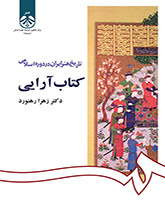
Persian Art History in Islamic Period: Illumination
This book is the fourth volume of the national research program on “a history of Iranian art in the Islamic period”.
The art of illumination (ketāb ā rā yi) is a traditional terminology and includes various artistic practices. This art is as profound and intricate as the magnificence and ornamentation of the book itself.
The art of illumination by itself, in its traditional meaning, is a school of art which encompasses all the various undertakings related to the binding and the pages of a book. In other words, it comprises the issues of form and content. From another point of view, illumination in its traditional scope of meaning is a collection of form, content, technique and minute expression. There are a list of artistic practices like, writing, penmanship, calligraphy, drawing, ornamentation, paint, and layout (safheh ā rā yi), and illustration as well as the quality and production of paper and methods of bookbinding.
When Iran entered the Islamic era, the art of illumination picked up great pace and in this way the conceptual symbols of this monistic religion found expression first in Quranic form with writing and illumination of the Quran and then it penetrated into the fields of science and literature.
This book explains a part of the traditional process of illumination in Iran in the Islamic era. The book is organized into six chapters. In these chapters the issues below are discussed successively: the art of illumination from the inception of Islam to the end of the Saljuqid dynasty; the dynasty of the Mongols; the Teymurid dynasty; the Safavid dynasty; the Qajar dynasty; a review of the transformation of the art of layout in the miniatures of the illuminated manuscripts from the very oldest versions to those of the Qajarid dynasty. The closing part of the book includes illustrations, definition of key terms of the art of illumination and the sources.




